‘Solely in the earth and its fruits’ – Papal Encyclicals and Irish social policy in the 1930s
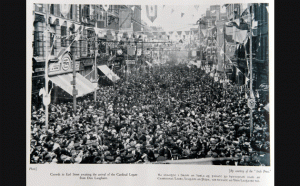
Barry Sheppard on how Catholic teaching helped to shape Irish social policy in the 1930s.
The 1930s – the era of the Great Depression and the rise of dictators across much of Europe was a tumultuous time. Ireland was no exception in the regard.
In this time of political and social upheaval, the teachings of the Catholic Church, in particular the Papal Encyclicals informed much Irish thinking on possible solutions to the problems of the day.
The political context
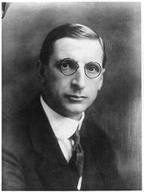
The relationship between Britain and Ireland during the 1930s was one of significant change, brought about through the change of government in the Irish Free State from the pro-treaty Cumann na nGaedheal to the more hard line Fianna Fáil administration under Eamonn de Valera in 1932.
This changeover of government and the ascent to power of the anti-Treaty Republicans in Fianna Fail, heralded many alterations to the relationship which emerged after the Anglo-Irish Treaty of 1921. Eamon de Valera’s government removed the British King as head of state, abolished governmental institutions such as the Governor General and the Senate and withheld payments owed to Britain – the Land Annuities – which had paid for land reform.
One of the consequences was the Anglo-Irish Trade War, more commonly known as the Economic War (1932-38), a trade dispute which was played out against the backdrop of the world wide depression of the 1930s.
In the 1930s the Irish state was buffeted both by great depression and by an ‘economic war’ with Britain.
This ‘trade war’ led to the implementation of trade barriers between the two states. It would also contribute to a breakdown in the relationship between the two countries which would not be repaired for some years.
Indeed, this era in Anglo-Irish relations is usually defined by the trade dispute which lasted for most of the decade. Nevertheless, on a non-government level there was a certain degree of cooperation between agrarian groups on the two islands which deserves a closer inspection. Although small-scale, it nevertheless shows a willingness of groups to cooperate in a common cause despite the lack of cordiality between their respective governments.
Motivated by the effects of unemployment and a severe lack of opportunities since the economic crash, and inspired by Papal teachings for guidance, a number of clerics and lay Catholics began to organise agrarian groupings which it was hoped would better the lot of their co-religionists who had been adversely affected by the harsh realities of a society shattered by the economic depression.
Catholic land reform
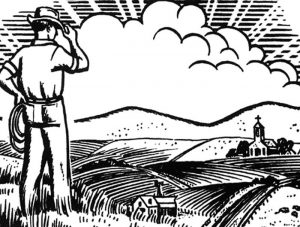
The Papal Encyclicals which inspired these groups were Rerum Novarum and Quadragesimo Anno, both of which had a significant impact on issues relating to land reform and creating new productive communities in 1930s Britain and Ireland, and further afield.
Two of the groups which were inspired by these encyclicals were The Catholic Land Association of Britain and Muintir na Tíre (People of the Land) in Ireland. Although the groups were separate, they had a number of connections which are interesting given the tense standoff which was happening at official government levels.
The movements were quite progressive, but as we shall see, central to each project was a longing for an idyllic past coupled with a desire to extract themselves, as far as possible from the turbulent economic and social climates of the 20s and 30s.
The Encyclicals.
Rerum Novarum was issued in 1891 by Pope Leo XIII on the “Rights and Duties of Capital and Labor”, in response to social conflict that had risen in the wake of industrialization. Forty years later in 1931, Pius XI’s issued Quadragesimo Anno. In this text Pius XI focused upon private property as essential for the development and freedom of the individual. It consolidated a number of themes from Rerum Novarum for a generation of Catholics confronted by huge economic upheaval, who viewed the texts as much needed guidance in dealing with a system many viewed as moving beyond control.
Catholic social teaching criticised both capitalism and socialism and advocated ‘back to the land’ movements as an alternative.
Containing critiques of both Capitalism and state-controlled socialism, the texts had the character of a finely balanced manifesto providing guidance towards an alternative to both ideologies, a third way by which Catholics could live.
Social and religious reform groups inspired by the texts began to establish cooperatives and ‘back to the land’ movements in various countries, from Belgium to Canada in an attempt to isolate people from the prevailing capitalist system as much as possible to an existence of small subsistence-farming, co-operative living and frugality. This was very much in line with Leo and Pius’ vision. The term frugality which was central to the text was also closely associated with de Valera and Fianna Fáil in Ireland. The following extract of Rerum Novarum gives a flavour of the teaching contained within. This extract is concerned with small subsistence living on the land and less reliance on the state in any form:
Man’s needs do not die out, but forever recur; although satisfied today, they demand fresh supplies for tomorrow. Nature accordingly must have given to man a source that is stable and remaining always with him, from which he might look to draw continual supplies. And this stable condition of things he finds solely in the earth and its fruits. There is no need to bring in the State.[1]
THE CATHOLIC LAND ASSOCIATION
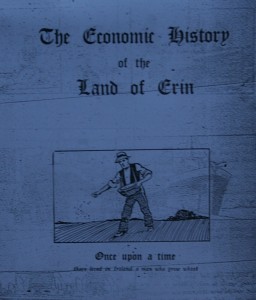
Passages like the one above were important to the groups which formed in the first half of the twentieth century, after the economic crash of 1929. It gave them the impetus to free themselves, as they saw it, from the system which had caused so much unemployment and misery.
In Britain a number of branches of the organisation named the Catholic Land Association sprang up throughout the country, with the first being formed in the Archdiocese of Glasgow on 31 May 1929, under a Rev John McQuillan, a priest of Irish extraction.[2]
This movement had, in part evolved from Distributism, the socio-economic theory popularised by the Catholic intellectuals G.K. Chesterton and Hilaire Belloc. Distributism was also influenced by the aforementioned encyclicals and argued that property ownership was a fundamental right, and the means of production should be spread as widely as possible, rather than being centralized under the control of the state, a few individuals, or corporations.
The first Fianna Fail governments, keen not to portrayed as radicals or socialists, associated their social policies with Catholic teaching.
It had further argued that the industrial age factory system would lead to the enslavement of the mass of working people who were controlled by a concentration of the rich few. In contrast, their vision was of widely dispersed small ownership, family farms, and co-operative workshops which would be owned by craftsmen.[3]
There was a growing appetite for this theory in Scotland where the first Catholic Land branch had been founded. In Glasgow University in 1930 there was a thriving Distributist club among the 500 Catholic students, again some of Irish extraction. (This club would eventually become more involved with Irish Nationalist politics. In the 1950s there was an attempt to elect two ‘jailed Sinn Fein MPs’ as Honorary Vice-Presidents of the Club).[4]
The establishment of Catholic Land Association branches in Scotland were greeted with much enthusiasm in Catholic Ireland. Favourable reports of the organisation appeared as early as 1931 in the Anglo-Celt newspaper. Later, The Irish Independent told its readers of a great ‘Progressive Movement in Scotland’ under the ‘Priest Pioneer’ McQuillan, which was helping to relieve economic distress in Scotland.
The article emphasised frugality by reporting how much being attained with little money. Stating that in the space of three years the branch had employed forty youths on a well-stocked farm with an estimated waiting list of 400 more people trying to obtain a place.[5]
The Fianna Fáil associated Irish Press were also quick to emphasise links with what was happening in Scotland and their party’s own government agenda. On 23 April, 1934 the paper stated that the aims of the Catholic Land Association in the main ‘bear a remarkably close resemblance to the economic policy being pursued in Ireland’. Such was the apparent success of the Scottish CLA branches that the Irish Independent in January 1935 claimed that people within Ireland were preparing to move to get a place in this ever expanding ‘Catholic Village’.[6]
Two settlements were established in Scotland, followed by several in England. Loans from benefactors enabled the South of England CLA to lease a farm in Buckinghamshire. The North of England CLA training farm was established in Parbold, Lancashire, and the Midlands group supported one at Market Bosworth, Leicestershire.[7] Interestingly, the South of England branch would seek help in their efforts from an surprising source, the Fianna Fáil government in Ireland. During this period the Fianna Fáil government had begun to establish their own rural colonies for Irish speakers, which also followed ideas laid out within the Papal encyclicals.
‘Nationalist and quasi socialist’
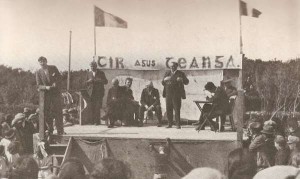
This scheme was primarily packaged as a programme for breathing new life into the Irish language. However, if one looks at the first Fianna Fáil Manifesto from 1926, it is apparent that several of their seven points for Government were inspired from the same encyclicals which inspired other land movements.
Certainly their ‘Gaeltacht Colony’ template was similar to what those other Catholic ‘Back to the Land’ movements were attempting elsewhere.
Indeed, many of Fianna Fáil’s social programmes were, according to Mary E. Daly: ‘an amalgam of nationalist and quasi-socialist policies often stolen from the manifestos of left-wing republican organisations, tempered by Gaelic antiquarianism and Catholic social teaching as found in papal encyclicals such as Rerum Novarum and Quadragesimo Anno.[8]
Fianna Fail tried to redistribute land to small farmers and also to create new Irish speaking communities outside of the traditional Gaeltachts.
The ‘quasi-socialist’ element was emphasised by Fianna Fáil’s opponents when they emerged upon the political scene. ‘Red scare’ tactics by newspapers such as the Irish Independent were designed to cause alarm among the electorate. The Irish Press responded, stating that Fianna Fáil’s policies were the opposite of Socialism:
According to the paper, the rights of the individual and family to own private property would be recognised while the government would provide work for the unemployed by establishing rural industries. Such a policy, the paper argued, was not socialism, but was in fact advocated by Pope Pius XI in Quadragesimo Anno.[9]
Some members of the Catholic Clergy also sought to allay those fears, in a letter to the Irish Press Rev Malachy Mac Branáin, curate in St Cuan’s Ballinasloe would defend Fianna Fáil’s Catholic credentials:
Allow me to state that in my opinion the economic policy of Fianna Fáil is neither Socialistic nor Communistic but, on the contrary, in accord with the Encyclical ‘Rerum Novarum’ of Pope Leo XIII. As a matter of fact, the general policy of the Fianna Fáil government in making the poor and distressed their first care and consideration is the surest remedy against Communism or Socialism.[10]
The Irish Press, was, as expected, vocal in emphasising Fianna Fáil leader, Eamonn De Valera’s close links with these encyclicals, in a 1937 editorial it stated that:
Mr de Valera has proved himself not merely a close student of these monumental documents, but a courageous statesman who is willing to give effect to the recommendations embodied in them.[11]
In the ‘Gaeltacht Colony’ project it can be argued that Fianna Fáil attempted to ‘give effect’ to the encyclicals recommendations. In 1934 in Irish speaking migrants from Connemara were given new holdings on average 22 acres in Co Meath, which was in keeping with the encyclicals and Fianna Fail’s own social vision. This programme was beset with many difficulties, nevertheless what is important is they attracted the attention of people attached to the CLA in Britain. Early in 1936 a request was made for assistance in establishing land colonies in England in a letter from a Miss Clare Maddock, a representative of the South of England CLA:
Would you be so very kind as to let me have any pamphlet you issue in connection with the small holding movement in Ireland (i.e., mixed family farming on 25-50 Acres) living on the produce and selling the surplus? I feel strongly such a move should be undertaken in this country. Perhaps our timid adventures might gather courage from your successful efforts.[12]
Although this was indeed high praise for such an enterprise, those within the Irish Land Commission and the government were reluctant to divulge any information. An internal memo stated that the scheme was still largely ‘experimental’ with the need to watch developments very closely at this stage.[13] While it is true the project was at an early stage, the response was not unlike others to those beyond the Emerald Curtain in relation to Irish social matters in this era. Nevertheless, it highlights what people viewed as common objectives, based upon the teachings contained within the encyclicals.
Muintir na Tíre
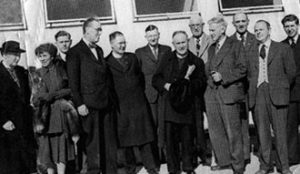
Outside of what could be termed, the ‘state-sponsored’ programme, the agrarian group Muintir na Tíre were themselves trying to reshape rural Irish life in line with Papal teachings.
The inaugural meeting of the group took place on 9th April 1931, with a number of issues up for discussion, including the organisation’s symbol, which was agreed to be that of a Cross and a Plough. A variation of the same symbol was also adopted by the CLA, and featured on their journal of the same name.[14]
Muintir an Tire – ‘People of the Land’ was founded in 1931 to reshape Irish rural life in line with Papal teachings.
This meeting also saw the adoption of a mission statement which enshrined the teachings within the two encyclicals as ways to achieving their aims.[15] However, one small, but not insignificant difference was laid out by John Hayes, founder of Muintir na Tíre.
As the CLA had become known as a ‘back to the land’ movement, Hayes stressed that his organisation was a ‘stay on the land’ movement. This was not a major departure from the ethos of the CLA, rather it highlighted the societal differences of the two islands, one being more heavily industrialised than the other and the need to tackle Ireland’s age old problem of emigration. Nevertheless, the general goal was the same, to change society from within.
As with the CLA in Ireland, Muintir na Tíre came to the attention of the British Catholic press. The Catholic Herald in August 1935 informed it’s readership that Muintir na Tíre was commanding considerable attention in its efforts in keeping people on the land in line with Catholic teaching. On another occasion it detailed one of the organizations projects, where 40 acres of land were divided into shares for 312 workers, all unemployed men.
Stating: ‘A single man gets one-eighth of an acre, a family man one quarter. Seeds, manure and plants are provided free; and the men have produced about £2,000 worth of food per annum for the past two years’.[16] The Catholic weekly The Tablet also ran articles promoting the Muintir na Tíre story, comparing the similarities between them and Britain’s CLA, from the size of some farms (approx. 30 acres), farming methodology and their shared ethos.
This movement took time to gather pace, and it was several years before the impact was felt. The organisation’s ‘Rural Week’ became the main event in Muintir na Tíre’s social calendar, where ideas were exchanged and speeches on social and religious issues were given by a wide range of people. One of the most important early speeches of this kind was given at the 1938 Rural Week, and highlighted a common cause by both Muintir na Tíre and their British counterpart, the Catholic Land Association.
The keynote speech was given by Mr H. Robbins, the chairman of the CLA of Britain. Robbins’ speech highlighted the similarities of Muintir na Tíre and his own organisation, acknowledging ‘that it must be a great consolation to all that the genius of our common philosophy had led widely scattered groups all over the world to an almost identical struggle for the departure from the crisis thrust upon us by industrial capitalism’.[17]
Successes and Failures
Both organisations, as one would expect, had their moments of triumph and tragedy. Funds were scarce during a world-wide economic downturn. While both operated outside of Government circles, the aims of one organisation, Muintir na Tíre were more closely aligned to that of their domestic government. Although financial backing was one thing which was not forthcoming from the relationship.
In the Dáil on 29 September 1939, de Valera praised the kind of work Muintir na Tíre was involved in, signalling a shift in his interests away from a very expensive colony project in Meath, to one which had a similar ethos, and crucially was being run on a voluntary basis. Indeed, he declined a reluctant request for a grant from Muintir na Tíre founder, Fr Michael Hayes around this period, stating that if this good work was to continue, it had to be done without government backing.
The CLA had similar investment problems. The British Government had enacted the Special Areas Acts of 1934 to deal with the long-term unemployed. Leading members of the CLA were dismayed at this, feeling that they had been bypassed despite informing the Government on a number of occasions at the need for such a programme to be implemented. Their dismay was voiced in their journal right up until the last edition in 1949.
Besides the government’s aforementioned Act, government grants were not available for the kind of family-owned, mixed subsistence farms favoured by the CLA. On top of this British Catholic bishops refused permission for a national collection, claiming that all the money they could raise was needed for building schools and churches in new housing areas.
Outside of economic matters, personalities in Muintir na Tíre and the CLA, specifically clergy members had an impact on the life of their respective organisations. One of the CLA’s main clergy members, Fr Vincent McNabb became an isolated figure within the organisation. The longing of a not too distant past which preoccupied a number of the organisation’s leadership wasn’t enough for McNabb. McNabb too wished to recreate an idealised past, however he claimed the Middle Ages were too close. He wished to go back further, stating: ‘We want to go further back, we want to go back to the first ages, not to Crecy and Agincourt, but to Jesus and Nazareth’.[18]
Setting up new rural model communities largely failed to lack of investment and th policy was shelved at the outbreak of the Second World War
This was in a way, a reflection of the writings of his close friend G.K. Chesterton who stated that to achieve a society of peasant proprietorship ‘the only step forward is the step back’.[19] Although it is not clear Chesterton had in mind the large step McNabb envisaged. McNabb’s continued insistence on this saw him – and consequently the CLA – become isolated from a Catholic Church which was increasingly committed to addressing urban moral decay via other forms of social action such, as charity work and public evangelisation.[20]
Muintir na Tíre were in a more favourable position under John Hayes. He was adept at bringing Irish history alongside his theology. In his writings he used religious language and referenced Irish historical figures such as Michael Davitt and Padraig Pearse, figures who people could rally behind; figures who had been and gone before the bitterness of the Irish Civil War and partition.
A 1971 article in Hayes’ local paper The Nenagh Guardian summed up what motivated him; a loyalty to his faith and a Gaelic, Free Ireland. Hayes himself, looking to this faithful and Gaelic Ireland said that: “The Ireland of our dreams, would be again the Ireland of the past”.[21] It was this blend of faith and patriotism which perhaps made Hayes a success, and consolidated Muintir na Tíre’s existence in Irish life, which lasts in a form to this day.
In many ways, the groups above recalled an idyllic past which they wanted to exist in. A past free of unforgiving modern economic conditions and political divisions. What is interesting is that, outside of Papal teachings they had similar, if unattainable aims.
Among some involved in the Gaeltacht colony project a desire existed to see a re-conquest of Ireland from within as an Irish-speaking nation, with the first colony being the catalyst for the spread of the language. Vincent McNabb in the CLA also voiced his hopes that the ‘Catholic colonies’ would do likewise in Britain, in terms of conversion to a Catholic nation once again. Muintir na Tíre, were perhaps the only organisation which did not produce such radical rhetoric, although it may be fair to say they wanted to refine their existing society. Perhaps they were more in tune with their immediate environment than the other groups.
The Second World War effectively put the brakes on these projects. The Gaeltacht colony project and the CLA slowed down around 1939, due to financial issues. The CLA thereafter found itself marginalised in a modernising post-war country. The Gaeltacht colony project did continue, though not with the same intensity as the first number of years. Muintir na Tíre however, fitted in to a society which was mostly rural and at a time when the national outlook was in many cases on the past, both politically and religiously, and which would not modernise for a decades to come.
References
[1] Pope Leo XIII ‘Rerum Novarum’ 4. <http://www.vatican.va/holy_father/leo_xiii/encyclicals/documents/hf_l-xiii_enc_15051891_rerum-novarum_en.html> 05/01/2014
[2] J. Kelly, Vincent McNabb, Agrarian Utopia and The Theology of Work (An exploration of the theology of the Catholic Land Association in relation to the social encyclicals Rerum Novarum and Laborem Exercens) p 289
[3] V. Flasetti, The Catholic Land Movement, (2002)
[4] F. McGowan, Moderate Radicals: The Distributists at Glasgow University: https://universityofglasgowlibrary.wordpress.com/2014/09/16/moderate-radicals-the-distributists-at-glasgow-university/
[5] Irish Independent, 9 June, 1932, p. 4
[6] Irish Independent, 28 Jan, 1935, p. 4
[7] Flessati
[8] Mary E Daly, Industrial Development
[9] M. O’Brien, De Valera, Fianna Fail and the Irish Press, pp47-48.
[10] The Irish Press 13/1/1933, p. 7.
[11] The Irish Press, 7/5/1937, p. 1
[12] Letter from South of England Catholic Land Association to High Commissioner For The Irish Free State 18/2/1936. DFA/132/11
[13] DFA/132/11
[14] The Cross and the Plough, Vol. 1, No. 1, 1934
[15] Inside Cover of Muintir na Tíre Handbook
[16] The Catholic Herald, PAGE 5, 3RD FEBRUARY 1939
[17] Irish Independent, 1 Sept, 1938, p. 10
[18] Valentine, Vincent McNabb, p. 287
[19] G.K. Chesterton, The Third Way, III. On Peasant Proprietorship
[20] Agrarian Utopia, Kelly
[21] Nenagh Guardian, 16 Oct, 1971, p. 11